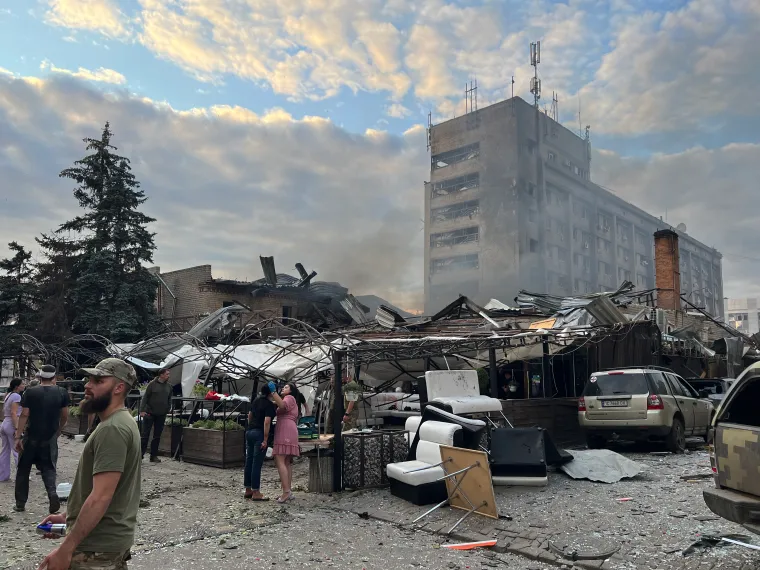It is around 7:30 p.m. on June 27 in the Ria Lounge, one of the few restaurants still open in Kramatorsk, a frontline city in eastern Ukraine. Known by regulars as “Ria Pizza” for its signature dish, the restaurant is packed on this summer Tuesday. Locals, aid workers, off-duty soldiers, and journalists have flocked here to eat before the kitchen closes in just 30 minutes. In Kramatorsk, which has come under regular shelling since the start of Russia’s full-scale war in Ukraine in February 2022, the curfew starts at 9 p.m. sharp.

British freelance photojournalist Anastasia Taylor-Lind and her Ukrainian producer Dmytro – who asked to be identified by his first name only for privacy reasons – are sitting at a table in a glass-walled, metal-roofed extension of the restaurant. The pair have just finished eating – their only hot meal of the day after spending hours in the countryside photographing the work of a Ukrainian demining unit. They discuss their reporting projects for the coming days and make appointments.
Suddenly, they hear a sound that Taylor-Lind describes as a “roaring engine getting closer and louder.” She knows instantly that it is a missile. She has heard similar sounds many times over her years reporting in eastern Ukraine, but always from a distance. This time, the weapon seems ominously close.
The Russian attack on Ria Lounge killed 13 civilians and wounded 61, including Taylor-Lind and Dmytro. In a war that has killed thousands of civilians, including at least 15 journalists in the course of their reporting, the attack is a stark reminder of the risks members of the media face to bring the world the news of the conflict and how such risks are hardly diminished when journalists are off duty. With Russia regularly striking civilian infrastructure and targeting locations near and far from the frontline, nowhere in Ukraine is truly safe.
“Everything happened in a split second,” Taylor-Lind told CPJ in an interview six days after the attack, which Russia claimed hit a Ukrainian army target. “I closed my eyes and I leaned forward, thinking that I would throw myself on the ground. While my eyes were closed, I heard a dull thud of the impact, and then I heard the sound of everything shattering and flying, the sound of all the glass breaking, everything coming through the air, and that sound went on for longer than the engine of the missile.”
She believes that the pair were sitting around 10 meters (33 feet) from the point of impact. “I opened my eyes and saw that there was blood on my left arm and leg and I felt that there was blood running down my face. I looked at Dmytro and saw he was bleeding from his head,” she said, an experience that was “incredibly frightening.” She said she felt responsible for Dmytro’s safety as she had hired him to work on her long-term photo project documenting life amid war in eastern Ukraine.
The two had been hit by pieces of glass and wall. Taylor-Lind’s leg, arm, nose, and head were cut and she had a mild traumatic brain injury from the blast wave. Dmytro was hit in the right side of his face, under his eye, and in his head, hand, and leg. He suffered headaches for days.
In the aftermath of the strike, they ran to the basement of the restaurant where fellow diners with first aid kits tended to their wounds before they managed to drive to the hospital in Dmytro’s badly damaged car. There, doctors stitched Dmytro’s face injury, dressed his head, and cleaned and disinfected Taylor-Lind’s cuts.
“I was incredibly lucky to sustain only light injuries, and am thankful my producer’s injuries were not life-threatening,” Taylor-Lind said. Dmytro’s car, essential for his work, was deemed irreparable by several mechanics. Taylor-Lind’s camera was also broken in the blast.
They weren’t the only journalists at the scene. Polish freelance photographer Wojciech Grzedzinski was also in the restaurant and photographed the aftermath of the strike, he said on Instagram. “It was just like in the movies,” he wrote. “Loud and quiet at the same time. I snuggle under the bench and the table.” Grzedzinski did not respond to CPJ’s message asking whether he was injured in the strike.
Catalina Gómez, a Colombian journalist with the Spanish-language service of French broadcaster France 24 and the Spanish daily newspaper La Vanguardia, told CPJ that she was having dinner at Ria Lounge when the missile hit. She said she was “in shock” but did not suffer any injuries. Nor did her Ukrainian producer, Dmytro Kovalchuk. The pair’s other dining companions fared worse. Sergio Jaramillo, a Colombian parliament member and Héctor Abad, a Colombian writer, were both hurt. Victoria Amelina, a well-known young Ukrainian author, was also sitting at the table. She was severely injured and died days later.
Looking back, Taylor-Lind said she doesn’t want her story to take the attention away from people like Amelina who died that day. Her experience, she said, is sadly not unusual for a journalist covering Ukraine.
“The fact is, we are just two of many media workers injured in Ukraine by Russian attacks in the course of our reporting work.”
Taylor-Lind left Ukraine after recuperating in Kyiv. But she plans to return soon to pick up where she and Dmytro left off – reporting on the war that has upended the lives of so many.
Editor’s note: The eighth paragraph has been updated to note that fellow diners helped the journalists with first aid kits.
